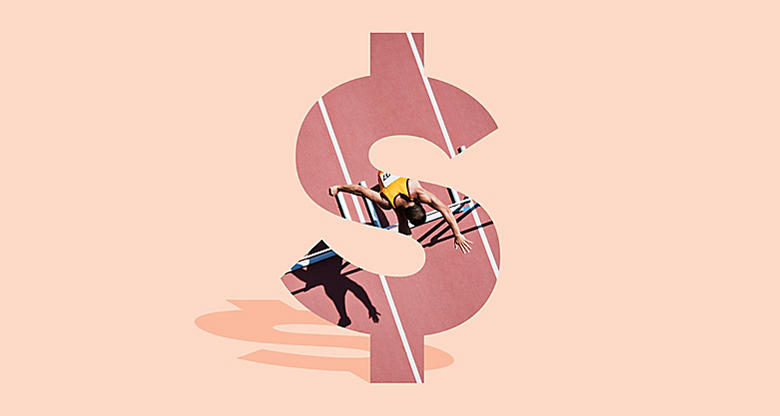This article is from the second issue of CommBank's magazine, Brighter.
We’ve all been there. One minute you’re innocently scrolling through Instagram, the next you’re the proud owner of a new pair of shoes. Or perhaps you dip into savings for a big night out rather than squirrel money away for a rainy day. These are completely normal spending behaviours. And common obstacles to saving.
Experts tell you that when it comes to achieving financial goals, having the right mindset is critical. The trick, of course, is knowing when yours is getting in the way of financial wellness. According to professor of psychology and expert on habits Wendy Wood, nearly half of our daily behaviour is automatic. So, we make a lot of decisions without considering whether it helps or hinders our longer-term goals (hello, stilettos). “It’s like going to the shops when you’re tired and you just grab the same things as always,” says William Mailer, chief behavioural scientist at the Commonwealth Bank. “You’re not always thinking through your choices.”
Common obstacles to saving include being overly optimistic, succumbing to instant gratification and fearing budgets. But there are ways to address them. The first step? Admitting you could be a better saver, says personal finance mentor Julia Scott. “Then set up systems to help you.” Here are a few ways to close the gap between your mindset and your savings goals.
Obstacle 1: You have a rosy outlook
We’re told to think positive. Consider the glass half full. Dream big. And usually, that’s a good thing. “A positive outlook helps us take chances, such as starting a business,” says Mailer. “And it can be great for our mental health.” The flipside of a sunny disposition is that it can actually hurt your financial wellbeing by stopping you from saving for a rainy day (think illness, divorce, redundancy or even retirement).
The tendency to overestimate the chance of positive events happening to us and to underestimate the likelihood of something bad happening is part of being human. It’s estimated that about 80 per cent of the population possesses “optimism bias” to some degree.
The question is, how can you remain rosy and still ensure you’re prepared for negative possibilities? To find balance, Mailer suggests an exercise called a pre-mortem. It’s used in project management to foresee things that could go wrong. “Imagine you’re two years into the future and you’ve missed all your financial goals,” says Mailer. “Write down what went wrong. It forces us to shine a light on the potholes that might be in front of us.” You could also try CommBank’s savings calculator to check how you’re tracking to achieve a financial goal like a trip or a rainy-day fund. If your savings plan isn’t on track, it’s never too late to make adjustments to your spending.
Obstacle 2: You want all the things... now
Mindless eating is the kind you do in front of the TV – one minute your bowl is full, the next it’s empty and you can barely remember chewing. Modern retail is a little bit like that, with only a click or two existing between a social media post or email and purchase. All of which reduces what economists describe as “the pain of paying”.
One of the best ways to avoid impulse shopping is to have a financial plan with meaningful goals. “If you don’t have a plan that includes setting a specific amount of money for discretionary spending, it’s easy to fall prey to instant gratification,” says Scott. Consider setting aside your monthly shopping allowance in a separate account. Once it’s gone you have to wait until next month before buying more.
Another tactic is to change your password or screensaver to something that provides a regular reminder of your goal, such as an image of a holiday destination. Also, reduce the number of emails you receive about sales and set up regular transfers that ensure your savings are immediately moved on payday to an account you don’t access for everyday spending. “Use the tools available to set up a system that means you don’t need to rely on willpower alone,” says Mailer.
Obstacle 3: Budget fear
“Budgets can be overwhelming and uninspiring,” says Scott. “Which is one reason many people don’t have a plan for their money.” We’re often reluctant to put our spending habits under a microscope, especially when that means inviting a partner to weigh in on how you like to spend. “We also suffer from ‘information avoidance’,” says Mailer. “If we don’t want to know how healthy our finances are, we might just ignore it.” It’s like avoiding the doctor when we think there may be something wrong.
Mailer’s top tip is to make budgeting as enjoyable as possible. “When you have to do something that’s difficult but important for your goals, combine it with something you enjoy,” he says. This technique is called temptation bundling. The idea is a simple one: research shows that people are more likely to find a behaviour attractive if they do one of their favourite things at the same time. Let’s say you love going out for breakfast on the weekend but you need to comb through your household expenses for last month. Using temptation bundling, you can hit the café on Saturday while reading over statements or some other budget- friendly activity.
Top tips
- Try CommBank’s savings calculator to reality-check a financial goal like a trip or a rainy-day fund. If your savings plan isn’t on track, make adjustments to your spending.
- Set up regular transfers that move savings to an account that you don’t access for everyday spending.
- Temptation bundling is a simple way to do tasks (like budgeting) that are important but easy to put off. Combining budgeting with a guilty pleasure will make it harder to ignore and easier to follow through on your goals.
Story by Jessica Mudditt
Read more articles from Brighter magazine.



